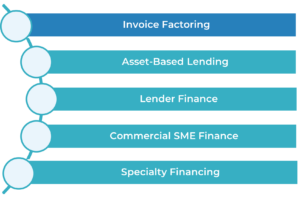How Do We Factor Invoices?
We’ve previously discussed the mechanics of invoice factoring, but what does this process look like in real-world practice? How do we ensure we’re mitigating risk while creating value and security for our investors?
Factoring is much more than purchasing invoices—it’s about understanding businesses, securing collateral, and verifying every step to protect our capital. Every deal is a puzzle, and while some fit perfectly into our risk framework, others reveal gaps too wide to ignore. Let’s explore how we differentiate between opportunity and uncertainty.

Finding the Right Fit: Two Case Studies
Not every invoice is created equal. Some businesses come to us with well-structured receivables and a clean financial track record, while others carry complexities that introduce unnecessary risk. Below are two real-world examples: one where the deal made sense for us and one where we ultimately walked away.
Deal We Funded: A $1.2MM Opportunity in Oilfield Trucking
A West Texas-based oilfield trucking company approached us with a $1.2MM factoring need. The company provides hauling and oilfield trucking services to major energy firms, and its receivables were tied to strong, creditworthy debtors. Their documentation was thorough—contracts, purchase orders, signed field tickets, and invoices all aligned, making verification seamless. While no business needs to be an expert in factoring, we appreciated their willingness to collaborate, ensuring we had the necessary transparency to validate their transactions.
Deal We Declined: A $1.5MM Construction Challenge
Meanwhile, a Calgary-based prefabricated construction firm sought $1.5MM in financing. The deal looked promising on paper: strong documentation, a reputable ownership team, and open communication. But as we dug deeper, the challenges became apparent—partial shipments, milestone-based billing, and subcontractor reliance created too many variables. Additionally, multiple existing lenders and Merchant Cash Advances (MCAs) complicated the structure, making it challenging to ensure our facility would be appropriately protected. Ultimately, we decided to pass.
Understanding the Client
One of the most critical aspects of factoring is deeply understanding our clients. What does their business do? How do they operate? What are the potential risks in their industry? These are fundamental questions we must answer before moving forward.
We spend significant time learning about each business and understanding its journey, current standing, and growth trajectory. This process allows us to tailor our approach, ensuring we not only acquire the proper invoices but also position ourselves as a strategic financial partner.
The oilfield trucking company’s operations were well-organized, and its leadership team was proactive in ensuring we had direct access to its customers’ accounts payable teams for seamless verification.
The construction company, however, raised red flags as we uncovered operational complexities—partial shipments, milestone-based invoicing, and reliance on subcontractors meant that our repayment structure would be less predictable.
The Importance of Documentation
In factoring, the collateral is everything. This means meticulously reviewing invoices, supporting documentation, the aging of receivables, and the strength of the debtor base before making any funding decisions.
Key areas of focus include:
- Analyzing invoice turnover, dilution rates, and receivable quality.
- Examining general ledger details and key contracts.
- Establishing appropriate advance rates and potential reserves based on risk assessment.
The oilfield trucking company’s records tell a story of reliability. Every invoice was backed by solid collateral—field tickets signed, purchase orders verified, and a clear track record of payments. They even used OpenInvoice, a platform that provided transparency into payment flows.
Conversely, while thorough, the prefabricated construction company’s records raised questions. The inclusion of electrical, plumbing, and subcontractor work blurred the lines of what we were truly financing. Layer in multiple Merchant Cash Advances (MCAs) and competing lenders, and suddenly our security position was far less certain.
Verification: Ensuring the Strength of the Transaction
A fundamental principle in factoring is that there should never be a single point of reliance. Our repayment depends on the debtor, so validating their ability to pay is paramount.
To do this, we:
- Establish direct relationships with debtors to confirm the legitimacy of invoices.
- Verify that goods or services were delivered and accepted.
- Conduct credit analyses to assess the financial health of the debtors.
For the oilfield trucking deal, this was straightforward. The company introduced us directly to their customers’ accounts payable contacts, and verification was seamless. They even structured payments to sub-carriers in a way that improved cash flow efficiency while reducing risk.
The construction company, however, had a more fragmented repayment structure. Multiple projects running concurrently, milestone billing, and subcontractor dependencies meant that payments weren’t as straightforward. The potential for delays—or even disputes—was significantly higher.
The Takeaway for Our Investors
Factoring is a highly structured, risk-managed form of lending that provides liquidity to businesses while securing strong, short-duration assets for our investors. Our rigorous due diligence and disciplined underwriting process ensure that we select transactions that align with our risk appetite while avoiding those that expose us to unnecessary challenges.
Some deals, like the oilfield trucking company, have all the right ingredients: strong collateral, clear payment structures, and a business that worked collaboratively with us to ensure seamless verification. Others, like the construction firm, may appear promising but, upon closer inspection, introduce risks that outweigh the reward.
Every decision we make prioritizes the safety of our investors’ capital. We are not just funding invoices—we are meticulously curating a portfolio of opportunities designed to deliver strong, consistent returns while safeguarding against downside risks. That is the essence of how we create value through private credit.





